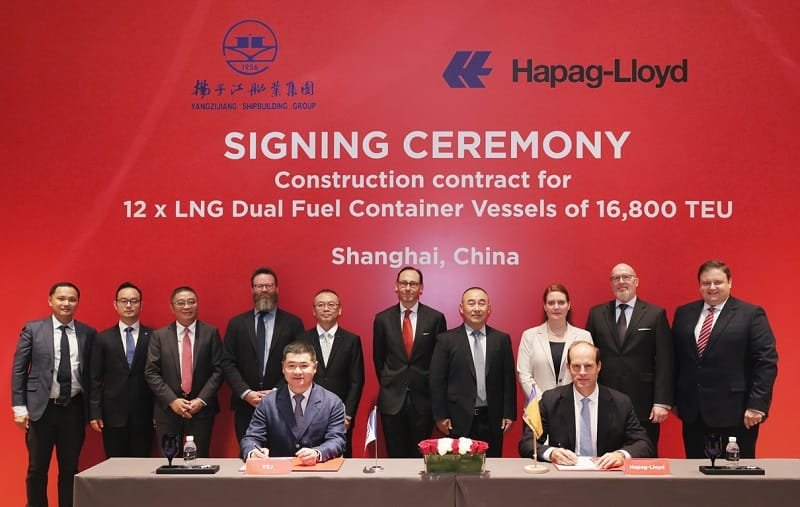Hapag-Lloyd has announced a major expansion and modernization initiative, placing orders for 24 advanced container ships with dual-fuel, liquefied natural gas (LNG) propulsion and ammonia-readiness. The German shipping giant has signed contracts with two prominent Chinese shipyards—Yangzijiang Shipbuilding Group and New Times Shipbuilding Company —in a move that reinforces the company’s Strategy 2030 and its commitment to reducing greenhouse gas emissions.
Table of Contents
Two Shipyards, Two Classes of Newbuildings
The contracts include an order for twelve 16,800 TEU container ships from Yangzijiang Shipbuilding Group, which will help expand Hapag-Lloyd’s capacity for its existing services. Meanwhile, New Times Shipbuilding Company Ltd. will construct twelve 9,200 TEU vessels aimed at replacing older units reaching the end of their service life. These modern ships will not only boost operational efficiency but also enhance service flexibility and support Hapag-Lloyd’s global shipping network.

Investment in Sustainable Technology
All 24 new vessels will be equipped with high-pressure, dual-fuel LNG engines, offering a state-of-the-art, low-emission propulsion option. These engines are also biomethane-compatible, potentially reducing CO2-equivalent emissions by up to 95% compared to traditional fuel systems. In addition, the ships are “ammonia-ready,” prepared for future fuel transitions that align with industry goals toward carbon neutrality.
The $4 billion investment includes a long-term financing commitment of $3 billion, underscoring Hapag-Lloyd’s dedication to building a sustainable and eco-efficient fleet. Delivery of the new ships is scheduled to begin in 2027 and will continue through 2029, adding a total capacity of 312,000 TEU.
A Strategic Commitment to Decarbonization and Growth
This latest fleet expansion is a significant step for Hapag-Lloyd’s Strategy 2030, which focuses on both growth and fleet decarbonization. CEO Rolf Habben Jansen noted the importance of this investment, saying, “This investment is one of the largest in the recent history of Hapag-Lloyd, and it represents a significant milestone for our company as it pursues the goals of its Strategy 2030, such as to grow while also modernizing and decarbonizing our fleet.”
Hapag-Lloyd’s commitment aligns with the 1.5-degree target of the Paris Agreement. The company aims to reduce greenhouse gas emissions across its fleet by about one-third by 2030 (compared to 2022 levels), with the ultimate goal of achieving net-zero operations by 2045. This ambitious target will be pursued through investments in newbuildings, fleet modernization, slow steaming, and alternative fuel options.
Preparing for a Multifuel Future
The 24-ship order complements Hapag-Lloyd’s recent decision to retrofit five vessels to methanol propulsion, reflecting the company’s strategic pivot toward a multifuel-ready fleet. By investing in LNG, biomethane, and ammonia-compatible technologies, Hapag-Lloyd is preparing itself for the diverse fuel landscape of the future while providing customers with greener transport options.
About Hapag-Lloyd
Hapag-Lloyd is among the world’s top liner shipping companies, with a fleet of 287 modern container ships offering a total transport capacity of 2.2 million TEU. Operating the largest fleet under the German flag, Hapag-Lloyd maintains a presence in 140 countries through 13,700 employees and 400 offices worldwide. In addition to its vast container fleet, which includes a leading reefer segment, the company has equity stakes in 20 terminals across Europe, Latin America, North America, India, and North Africa, offering comprehensive logistics services at select locations.
This substantial investment signals Hapag-Lloyd’s dedication to future-proofing its fleet while actively contributing to the decarbonization of the maritime industry. Through these strategic moves, Hapag-Lloyd is not only enhancing its competitive edge but also solidifying its role as a leader in sustainable global shipping.
Source Hapag-Lloyd

